

The Big List of Class Discussion Strategies. Doing and Talking Math and Science: Teach the Language of Complex Thinking. When we present students with intriguing challenges to think through, some will jump right in and others will hold back.
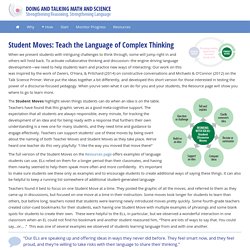
To activate collaborative thinking and discussion--the engine driving language development—we need to help students learn and practice new ways of interacting. Our work on this was inspired by the work of Zwiers, O’Hara, & Pritchard (2014) on constructive conversations and Michaels & O’Connor (2012) on the Talk Science Primer. We’ve put the ideas together a bit differently, and developed this short version for those interested in testing the power of a discourse-focused pedagogy. When you’ve seen what it can do for you and your students, the Resource page will show you where to go to learn more. The Student Moves highlight seven things students can do when an idea is on the table.
The full version of the Student Moves on the Resources page offers examples of language students can use. Teachers found it best to focus on one Student Move at a time. Notebooking / PBL: Why Sense-making Notebooks? Why Sense-making Notebooks?

Science is not science until it is published! Communication is key to scientific discovery. Scientists share their ideas, results, and questions through their writing. In classrooms, we want students to have parallel experiences as they discover and shape their thinking about science. Rather than passive absorbers of information, students need to be actively engaged in the process and practices of science. To learn more about Notebooks, click Next. SAGE Journals: Your gateway to world-class journal research. Strong reading comprehension is essential for academic and professional achievement, as well as for civic engagement and social life (Snow, 2002).

Students who are English learners (ELs) have the asset of developing knowledge of more than one language (Goldenberg, 2008), but they are also more likely than monolingual students to have difficulties with reading comprehension in English in the United States (Mancilla-Martinez & Lesaux, 2010; National Center for Education Statistics, 2015). Understanding second-language (L2) reading comprehension development in students who are ELs is an important step in effectively supporting their reading comprehension in L2. Currently, relatively little is known about L2 reading comprehension, as the body of research investigating components contributing to L2 reading comprehension is still emerging (August & Shanahan, 2006; Samson & Lesaux, 2015).
Conceptual Framework. Argument Tool and Rubric – Google Drive. Tools & rubrics (explanation and argument) – Google Drive. Neilson-Campbell 2018.pdf. Engaging in Computational Thinking Through System Modeling – Concord Consortium. What is the effect of reintroducing wolves to Michigan’s Isle Royale National Park?

How is CO₂ affecting our oceans and the organisms that live there? How can something that can’t be seen crush a 67,000 lb. oil tanker made of half-inch steel? Solving such questions requires thinking about the interrelated factors in a system: predators, prey, and various parts of a park ecosystem, for example, or carbon dioxide, acidity of the water, and shellfish health, and so on. Most critical issues facing us today can be modeled as a complex system of interrelated components, involving chains of relationships and feedback between parts of the system.
A common approach for understanding and solving problems such as these involves using a computer to simulate a model of the system. Students Learn More With Active Learning, Despite Preferring Lectures. Students are often “poor judges” of their own learning, according to researchers in a study recently published in the Proceedings of the National Academy of Sciences.
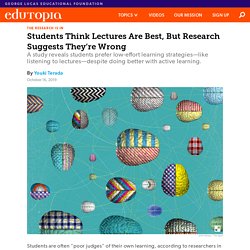
Strategies that require low cognitive effort—such as passively listening to a lecture—are often perceived by students to be more effective than active strategies such as hands-on experimentation and group problem-solving. The group dynamic can make students feel frustrated and “painfully aware of their lack of understanding,” but the study concluded that the more effort and struggle involved—hallmarks of a student-centered, active approach—the more students learned. In the study, researchers divided large introductory physics courses at Harvard University into two groups.
For both groups, instructors primarily lectured for the first 11 weeks of the 15-week course. Minimizing resistance. How Can Elementary Teachers Improve Their Ability to Run Productive Science Discussions. By: Hilda Borko, Ph.D., Charles E.
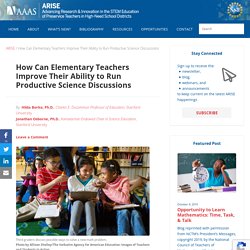
Ducommun Professor of Education, Stanford University Jonathan Osborne, Ph.D., Kamalachari Endowed Chair in Science Education, Stanford University Leave a Comment Third graders discuss possible ways to solve a new math problem. Precipitation Towers: Modeling Weather Data Activity. A Structural Model of Elementary Teachers' Knowledge, Beliefs, and Practices for Next Generation Science Teaching. Reading to Learn in Science. How Can Elementary Teachers Improve Their Ability to Run Productive Science Discussions. Ten Questions for Mathematics Teachers… and How PISA Can Help Answer Them. Effective Teacher Professional Development REPORT.
STEM curriculum for K-12. Crosscutting Concepts Graphic Organizers. Visible Thinking. To Pin or Not to Pin? Choosing, Using, and Sharing High-Quality STEM Resources. Changes in How We See Scientific Inquiry. Ask 20 teachers what scientific inquiry is and it’s possible you’ll receive 20 different answers.
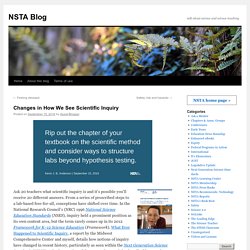
From a series of proscribed steps to a lab-based free-for-all, conceptions have shifted over time. In the National Research Council’s (NRC) 1996 National Science Education Standards (NSES), inquiry held a prominent position as its own content area, but the term rarely comes up in its 2012 Framework for K–12 Science Education (Framework).
What Ever Happened to Scientific Inquiry, a report by the Midwest Comprehensive Center and myself, details how notions of inquiry have changed in recent history, particularly as seen within the Next Generation Science Standards (NGSS). A further section of the report that won’t be described here analyzes how the science standards of upper Midwest states describe inquiry. Historical beginnings Standards era shift Framework and the NGSS 1) Inquiry is a means for constructing scientific understanding; it’s not a content area As Dr. Final thoughts Follow NSTA. Science Lesson Preparation and Planning Tool. Science Lesson Preparation and Planning Tool.
Clarifying Literacy in Science. Notions of literacy in science run in several directions that do not always have clear definitions or delineations.
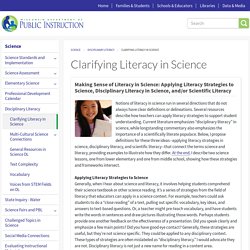
Several resources describe how teachers can apply literacy strategies to support student understanding. Current literature emphasizes “disciplinary literacy” in science, while longstanding commentary also emphasizes the importance of a scientifically literate populace. Below, I propose definitions for these three ideas--applying literacy strategies in science, disciplinary literacy, and scientific literacy--that connect the terms science and literacy, providing examples to illustrate how they differ. At the end, I describe two science lessons, one from lower elementary and one from middle school, showing how these strategies and frameworks intersect. Applying Literacy Strategies to Science Generally, when I hear about science and literacy, it involves helping students comprehend their science textbook or other science reading. Elementary. Classroom Video Gallery. Search form Classroom Video Gallery The Institute for Inquiry filmed two days of instruction in two Sonoma classrooms to capture how teachers were translating ideas and principles explored through professional development into their teaching practice.
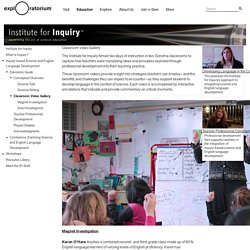
These classroom videos provide insight into strategies teachers can employ—and the benefits and challenges they can expect to encounter—as they support students to develop language in the context of science. Each video is accompanied by interactive annotations that indicate and provide commentary on critical moments. Magnet Investigation. RELATING RESEARCH TO PRACTICE. PEEC 1.1 NGSS Innovations. Developing and Using Models Protocol.pdf. A Framework to Evaluate Cognitive Complexity in Science Assessments. How Collaboration Unlocks Learning and Lessens Student Isolation. Uri at first asked the other mathematics faculty what they thought the reason was.
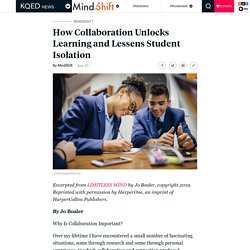
They came up with a range of reasons: perhaps African American students came into the university with lower math scores or an insufficient mathematical background; perhaps they were from less wealthy homes. None of these suggested reasons were correct. What Uri found, through studying the students at work, was that there was one difference—the African American students worked on math problems by themselves, whereas the Chinese American students worked collaboratively. The Chinese American students worked on their assigned math problems in their dormitories and in the dining halls, thinking about them together. 7 Smart, Fast Ways to Do Formative Assessment. Reading to Learn in Science.
Large Scale Scientific Modeling Practices That Can. 5 Tips for Blending The Question Formulation Technique (QFT) with NGSS. Have you ever interviewed a group of your students about their experiences in your classroom? It is amazing how much you can learn from your students’ perspectives, especially when you are experimenting with new methods. Redefining vocabulary in science instruction - Central Rivers AEA. Icans I2 SE.
Just in Time Instruction. GROUP LEARNING ROUTINES - Resources Index. Moodle. Khan Academy and the Effectiveness of Science Videos. Corteva. NGSS Practices Poster Directions & Printables. .2019. Through Course Task (TCT) - Kentucky Department of Education. 2018-2019 Through Course Task (TCT) Expectations Over the past two years, each district was requested to submit samples of student work for through course tasks (TCTs). These submissions were used to create annotated student work samples to support teacher learning regarding grade band expectations for the cross-cutting concepts and science and engineering practices. Due to the high number of work samples submitted, the Kentucky Department of Education (KDE) will shift its focus from that of collection to curation and support.
As a result, no student work samples from TCTs will be collected during the 2018-2019 school year. Transforming Science Assessment: Systems for Innovation. Integrating Science and Engineering Practices into Assessments. The new vision for science education articulated in the Next Generation Science Standards guides students toward a “three dimensional” understanding of science—one that integrates disciplinary core ideas, crosscutting concepts, and real-world practices from science and engineering. With this new three-dimensional model for learning, students will need new assessments to demonstrate their knowledge and competencies, ones that integrate multiple strands of student abilities.
Developing assessments that combine these multiple strands presents new challenges for educators, from developing informal classroom formative assessments to those creating high-stakes state-level testing. This tool offers between four and eight possible task formats for each of the science and engineering practices listed in the Next Generation Science Standards. It can be a great way for educators to brainstorm new activities or to adapt their existing lesson plans to this new three-dimensional vision. An Educator's Guide to NGSS. Experiencing-the-QFT.pdf. Designing Group Projects So That Everyone Participates. Eliciting students’ ideas. Eliciting students’ ideas Why do we use these particular practices?
Our main objective as science teachers is to change students’ thinking over time, so we need to know what our students understand about the target science ideas in the first place. Real World Problems Can Spark STEM Lessons. A MiddleWeb Blog Authentic STEM focuses on problem-solving, and the best STEM lessons address some aspect of a real-world challenge that engineers and scientists might address. Why should students learn to plan and carry out investigations in science and engineering? YCCS Key Practices - UC Davis School of Education. MatrixOfCrosscuttingConcepts. Will new standards improve elementary science education? The Hechinger Report is a national nonprofit newsroom that reports on one topic: education. Sign up for our weekly newsletters to get stories like this delivered directly to your inbox. Next Generation Science Standards: What’s different, and do they matter? Back Pocket Questions - Connie Hamilton.
Express 13.05 - What Makes a Collaborative Classroom Work? Response: Don't 'Steal the Aha' From Science Instruction. 3D5E Learning Sequence Planner. Frameworks used for Developing Units, Tasks, and Assessments. Units. Tools — Next Generation science storylines. Open Strategy Sharing - Engineering Applied. STEM teacher preparation as a process of purposeful disruption and rebuilding. By: David Stroupe, Ph.D., Associate Professor of Teacher Education, Michigan State University Leave a Comment “…new designs for teacher professional learning cannot simply be innovative; they must be disruptive” – Ann Rosebery, Co-Director, Chèche Konnen Center, 2016 Students in underserved schools, particularly minoritized students, are often denied opportunities to participate and excel in STEM fields.
Sadly, such students’ academic abilities and life experiences tend to be seen as seen as detriments to their success (Boser, Wilhelm, & Hanna, 2014). More broadly, schools and STEM fields purposefully create a hierarchy of participation using race, culture, language, and economic class to limit minoritized students’ possibilities (Parker, 2018). Study Explores What Makes Strong Science Teachers. BPS Science Practices - Home. Getting Inside Students' Minds: Why Misconceptions Are So Powerful. Sc1607_28. (NGSS) Using Crosscutting Concepts in Every Grade. Using Crosscutting Concepts To Prompt Student Responses Science. Scaffolding the Crosscutting Concepts: Graphic Organizers in Action in the Middle School Classroom.
The crosscutting concepts have great potential to help students connect their learning across grade levels and science disciplines, but they can easily become the forgotten “third dimension.” 149. Copy of Crosscutting handouts Gr6.12 [PRINT FILE] (1).pdf. Ccc sentence stems.